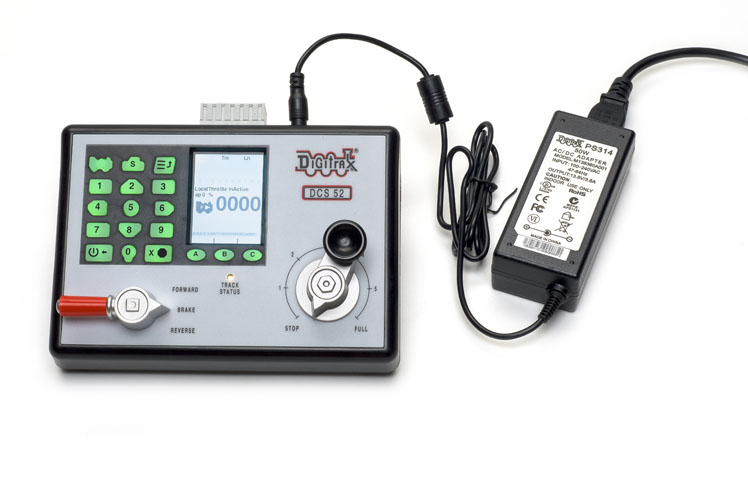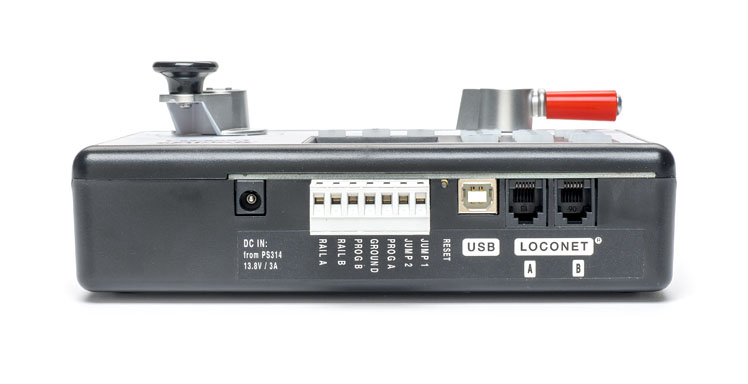Running a model railroad with Digital Command Control is a simple task with the DCS-52 Zephyr Express from Digitrax. Combing a DCC command station, booster, and stationary throttle in one convenient package, the Zephyr Express is an updated version of the firm’s DCS-50 Zephyr and DCS-51 Zephyr Xtra (reviewed in the May 2011 issue) systems. With its updated user interface, the Zephyr Express is a plug-and-play DCC solution that won’t intimidate novices. However, don’t let the system’s simplified appearance fool you. It’s also feature-rich enough to satisfy more experienced DCC users.
Up and running. The Zephyr command station measures 5″ x 7¼”. After plugging in the included 3A power supply, I connected the Rail A and Rail B screw terminals to the mainline track leads. Once the track status indicator lit up, I was ready to run trains with the system.
I appreciated that the screw terminal block on the back of the command station also includes connections marked Prog A and Prog B, making it easy to set up an isolated programming track. The Zephyr supports both service mode programming and programming on the main (also called ops) programming.
The built-in locomotive controls will be familiar to users of previous Zephyr systems. The direction lever can be set for forward, reverse, or brake. The throttle knob is reminiscent of a direct-current (DC) power pack.
Compared to earlier Zephyr command stations, the Zephyr Express features simplified and more user-friendly controls, featuring 18 backlit keys vs. 24 buttons on the Zephyr Xtra. The Zephyr Express also features a large 2.4″ color liquid crystal display (LCD) screen.
When running a train, the screen shows the locomotive number, speed as a percentage of the throttle, locomotive direction, and which functions are active. Other tasks, including programming configuration variables (CVs), are achieved by navigating intuitive on-screen menus.
Along the bottom of the screen are three soft keys marked A, B, and C that are used to navigate through the menus. The purpose of each key is shown above it on the screen. For example, when running a locomotive, Fn+00 appears above button A. That means that the numeric keypad triggers functions 0-9. If I pressed A again, the note changed to Fn+10, meaning the keypad triggers functions 10-19. One more press changed the note to Fn+20, to gain access to functions 20-28.
Following screen prompts, I easily changed locomotive addresses, programmed CVs, and consisted locomotives. For each step of the process, informational text scrolled across the bottom of the screen to help me remember what I needed to do next.
The command station also includes a Switch key used for activating accessory decoders or for changing option switches (OpSw) on other LocoNet-supported devices.
Expanding the system. There are two LocoNet ports on the back of the command station, which makes it easy to expand the system with additional throttles, boosters, wireless throttle receivers, and other components. LocoNet is a command bus protocol developed by Digitrax that the firm also licenses to other manufacturers.
Digitrax infrared and radio receivers will work with the system for those who wish to add wireless walkaround control. Additional fascia plug ports are available for tethered throttles. The Zephyr also supports the Digitrax LNWI WiFi interface, which allows users to run trains via a smartphone app.
When properly configured as outlined in the instruction manual, two terminals (Jump 1 and Jump 2) allow two DC power packs to be connected to the command station to function as two additional DCC throttles.
The built-in PR4 computer interface is my favorite new feature. I plugged in a USB cable from my Mac to the port on the Zephyr Express, and then opened Java Model Railroad Interface (JMRI) software. Available as a free download at www.jmri.org, this software includes DecoderPro, which is an intuitive tool for programming and testing DCC decoders. Note that Windows PC users will have to download additional drivers, but these are available as free downloads at the Digitrax website.
The Digitrax Zephyr was a solid DCC starter set when it debuted more than 15 years ago. With its updated user interface and added features, this latest version is better than ever.
Manufacturer
Digitrax Inc.
2443 Transmitter Rd.
Panama City, FL 32404
www.digitrax.com
Features
• Advanced, universal, and simple consisting
• Built-in USB computer interface
• Firmware updates via free download
• LocoNet ports for easy expansion
• Maximum number of addresses: 9,000 plus (locomotive), 2,000 plus (accessory)
• Maximum number of throttles: 20
• Programming on the main or Service Mode programming with separate programming track outputs
• PS314 13.8V, 3A power supply
• Supports 29 functions
• Two- and four-digit addressing
• Two LocoNet ports for additional throttles and other components















